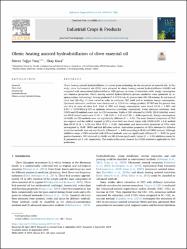Publication Preview Source Ohmic heating assisted hydrodistillation of clove essential oil
Access
info:eu-repo/semantics/restrictedAccessDate
2019Access
info:eu-repo/semantics/restrictedAccessMetadata
Show full item recordAbstract
Ohmic heating assisted hydrodistillation is a novel green technology for the extraction of essential oils. In this
study, clove bud essential oils (CEO) were extracted by ohmic heating assisted hydrodistillation (OAHD) and
compared with conventional hydrodistillation (HD) process, in terms of extraction yield, energy consumption
and chemical properties. Ohmic heating assisted hydrodistillation process conditions were optimized by response surface methodology. Voltage gradient (7.5–12.5 V/cm, A), process time (30–120 minutes, B) and mass of
clove bud (20–40 g, C) were varied in order to maximize CEO yield and to minimize energy consumption.
Optimized extraction conditions were determined as, 12.5 V/cm voltage gradient, 97.967 min for process time
and 40 g of mass of clove bud. Yield of CEO and energy consumption were found 13.18 ± 1.50% and
0.214 ± 0.030 kW h/g CEO at optimum extraction conditions, respectively. Under optimum conditions, both
OAHD and HD methods were used for CEO extraction. Yields of CEO obtained by OAHD, HD-D (distilled water)
and HD-S (salted water) were 13.18 ± 1.50, 8.23 ± 0.35 and 7.88 ± 0.60 respectively. Energy consumptions
of OAHD and HD methods were not significantly different (P > 0.05). The main chemical component of CEO
was eugenol and the yield of eugenol (g/100 g clove bud) was found higher with OAHD (6.95 ± 0.6) method
than HD-D (5.16 ± 0.20) and HD-S (5.13 ± 0.28). Antioxidant and antimicrobial properties of CEOs were
investigated by FRAP, DPPH and disk diffusion method. Antioxidant properties of CEOs obtained by different
extraction methods were not significantly different (P > 0.05) according to FRAP and DPPH analysis. Although
inhibition zones of CEOs extracted with different methods were not significantly different (P > 0.05) for gram
positive bacteria’s, CEO obtained by OAHD and HD-D have significantly higher (P < 0.05) inhibition zones for
K. pneumonia and E. coli, respectively. The results of this study showed that OAHD method is applicable for CEO
production.
URI
https://hdl.handle.net/20.500.12440/1407https://www.sciencedirect.com/science/article/pii/S0926669019307733?pes=vor


















